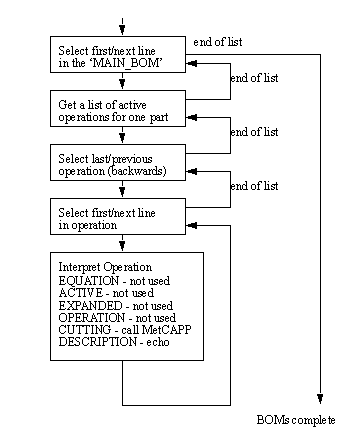1.2 CONVERTING PROCESS PLANS TO OPERATION SHEETSIn the previous chapter the planning system was described, including how the process plan is represented. In the simplest of approaches, this plan can be directly converted to lists of processes. We can enhance these encoded descriptions by using additional process, and operation planning software. A sample of part of a process plan is shown in Figure 1.1 Output from Process Planning for Operation Planning for discussion. The method for expanding the process plan information is quite straight forward. The documentation produced is in the form of Operation Sheets that include operation information. If referring to the example above, there will be a separate Operation Sheet generated for each of the line entries in the ‘MAIN_BOM’ set. This set is ordered such that the parts at the top of the list should be produced before the following parts. This does not mean that operations cannot be changed in order, but it does specify one of the possible manufacturing sequences. Each line in the ‘MAIN_BOM’ set specifies whether a part is an ‘ASSEMBLY’, or a ‘FEATURE’. The first argument represents how many of the ASSEMBLY ( 2.000000 Clip_half Clip_half_OP1 Clip_half_PART ) ASSEMBLY ( 1.000000 0:Logo_Side 0:Logo_Side_OP13 ASSEMBLY ( 1.000000 Logo_Side Logo_Side_OP26 Logo_Side_PART ) ASSEMBLY ( 1.000000 Spring Spring_OP33 Spring_PART ) ASSEMBLY ( 1.000000 Big_Clothes_Pin Big_Clothes_Pin_OP42 EQUATION: ( & ( ~ B ) ( ~ C ) ( & A E ) ( ~ D ) ) OPERATION ( AND RULE 2:0:0 507.851500 Clip_half_OP2 drill_hole ) OPERATION ( AND RULE 3:0:0 0.000000 Clip_half_OP3 mill_wedge ) OPERATION ( AND RULE 4:0:0 507.851500 Clip_half_OP4 drill_hole ) CUTTING ( FEATURE single diameter hole ) CUTTING ( MATERIAL polypropylene ) CUTTING ( PARAMETERS 0.072500 0.5 1.0 ) EQUATION: ( & ( ~ C ) ( & A E ) ( ~ D ) ) DESCRIPTION ( mill out block shape ) CUTTING ( FEATURE Flat Rectangular Surface - Open, CUTTING ( MATERIAL polypropylene ) CUTTING ( PARAMETERS 10 10 10 ) EQUATION: ( & ( ~ B ) ( ~ C ) A ( ~ D ) ) OPERATION ( AND RULE 5:0:0 507.851500 Clip_half_OP5 drill_hole ) OPERATION ( AND RULE 6:0:0 507.851500 Clip_half_OP6 drill_hole ) parts are required in the design. The second argument is the name of the part in the original design. The fourth argument is a reference to a set that contains a single geometry expression for display purposes. And, finally the third field points to the head of a tree of operation sets. If we follow the plan direction for the ‘Clip_half_OP1’ we find a set that has some ‘OPERATION’ information, an ‘EQUATION’, and an ‘ACTIVE’ pointer that says operation ‘1’ is active, therefore the second ‘OPERATION’ is selected (0 would be the first ‘OPERATION’). The ‘EXPANDED’ operator is only used by the planner for restarting planning that has been stopped by keeping track of where the planner stopped. The first operation pointed to from the ‘MAIN_BOM’ (in this case ‘Clip_half_OP1’) is a special case in that it contains no plan operation information, but points to a number of drastically different plans. When deciding which operation comes next we must follow the trail of the ‘ACTIVE’ ‘OPERATIONS’. At this point in the discussion the second ‘OPERATION’ is active, and it points to ‘Clip_half_OP2’. Looking at this operation reveals that there is much more information than in the previous operation. The reader should note that the ‘EQUATION’ in this operation is now changed from the previous operation. At this point operation planning would be performed, and there would be details added to the operation lists. The operator ‘DESCRIPTION’ will cause the arguments to be directly echoed to the operation lists. On the other hand ‘CUTTING’ will result in calls to MetCAPP, which will eventually suggest tools, cutting sequences, speeds, feeds, and other cutting information. The interpretation of these will be discussed in more detail later. After all of the planning fields are completed, then the next ‘ACTIVE’ ‘OPERATION’ will be selected, and planning will continue until no ‘ACTIVE’ pointer is found. This should also coincide with an ‘EQUATION: NULL’ if planning was completed. The plan steps are actually reversed in the sequence described above. This is a result of the backwards planning approach. Therefore the plan steps are reversed when printed on the plan. There are also operation numbers assigned to each operation step. This is done to maintain consistency with the typical industrial practice. A flowchart of the operation planning section is shown below. 
As can be seen the process of developing operation sheets is just a case of looping iteratively. The place for other CAPP technologies and software is in the ‘Interpret Operation’ block. As is described, MetCAPP is used here, as other CAPP systems could be as well. Also of interest is a sample of the operation sheet produced from the lines above. A sample is given below. OPERATION SUMMARY_SHEET: Clip_half_PART - Quantity 2.000000 ------------------------------------------ 0 cut a block from stock with hot wire Here we see that the list ends with ‘mill out block shape’. This was the first operation in the list, and therefore it is the last in practice. Each of the operations has a separate number to identify it as one process step. The reader will notice the ‘DESCRIPTION’ in the initial operation description echoed its text to the BOM. The reader should also note that a total of two parts are specified at the top of this BOM. When the entire plan is done, there will be a list of similar sheets for all parts of the product. |